MedMinder, Maya : Review
By: Editorial Team | Posted: January 14, 2020 | Updated: April 25, 2023
The Basics
- Product: Maya
- Company: MedMinder
- Review Date: Q1 2020. | Updated August 2020.
Where to buy it or learn more*:
Discount for Tech-enhanced Life readers:
- Discount code:
- Discount amount:
Analyst Summary: MedMinder | Maya
The MedMinder is designed to help you improve your adherence to the medication regimen prescribed by your healthcare providers. It does that by helping to organize your medication; reminding you which pills to take and when to take them; and helping you to refill your prescriptions when you need to.
This product is included in our comparative analysis of the entire class of automatic pill dispensers. If you are not sure yet whether this product is the one you need, that comparative evaluation should help you understand which pill dispenser will work best for your life situation.
Unlike the family of “robot pill organizer / dispensers” (see article above for details), which we see as “competing products” to this one, the MedMinder does NOT do the work of organizing your pills into different dose groupings for you inside the system.
Instead you have two options. You can do that pill organizing yourself, very similar to how you would do it for a conventional pill box.
OR, you can take advantage of a simple system by which the pharmacy does the pill organizing for you and ships you a tray that can be put into the MedMinder.
With the second option, there is no longer any need for you to painstakingly sort pills into different sections of a pill box according to when they need to be taken.
This product comes in two versions: The Maya, which we evaluated, and a very similar product called the Jon, which has some additional locking capabilities, which we call out in several sections below.
Update August 2020:
Since we did this review, the company has come out with a newer version of the product, which we have studied online but not evaluated hands-on. As best we can tell, the new product version continues to function as described below, with the addition of a “screen” attached to the top of the device. The screen allows the product to add some functionality (pictures, visual alerts for example).
We believe the primary functions of the product remain unchanged, and in fact you can see in pictures of the newer version that — other than the addition of the screen — the rest of the product appears unchanged.
We continue to rate this product highly, and believe you should be able to rely on the material below in the review.
Which Medications Can It Handle?
This product does NOT have limitations concerning gel capsules, or gummy medications, or half pills, as do most of the “robot pill organizer / dispensers” with which it competes. It does not handle liquid or non-room temperature medications. It does not seem to be setup to easily “remind you” to take medication such as insulin that is not contained in the system itself.
User Interface (UI)
One of the common scenarios in which these types of products will be used involve two different people. One, which we call the “dispensee”, is the person who consumes the medication, and who needs to interface with the machine when it is time for the medications to be dispensed.
The second, which we call the “filler”, is the person who worries about putting the right medication into the system every week or month, and who sets up the “dispensing schedule” according to whatever schedule has been prescribed by the physicians of the dispensee.
In many scenarios, the filler will be a caregiver, or spouse, or adult child of the dispensee. However there will also be situations in which the dispensee also performs the job of the filler (i.e. when you worry about your own medication management instead of involving someone else).
This product is designed to look like, and to be interacted with like, a conventional pill box. The primary user interface is the series of pill compartments which you can open and close when needed. The system gets your attention with lights and sounds and various types of notifications (eg text messages).
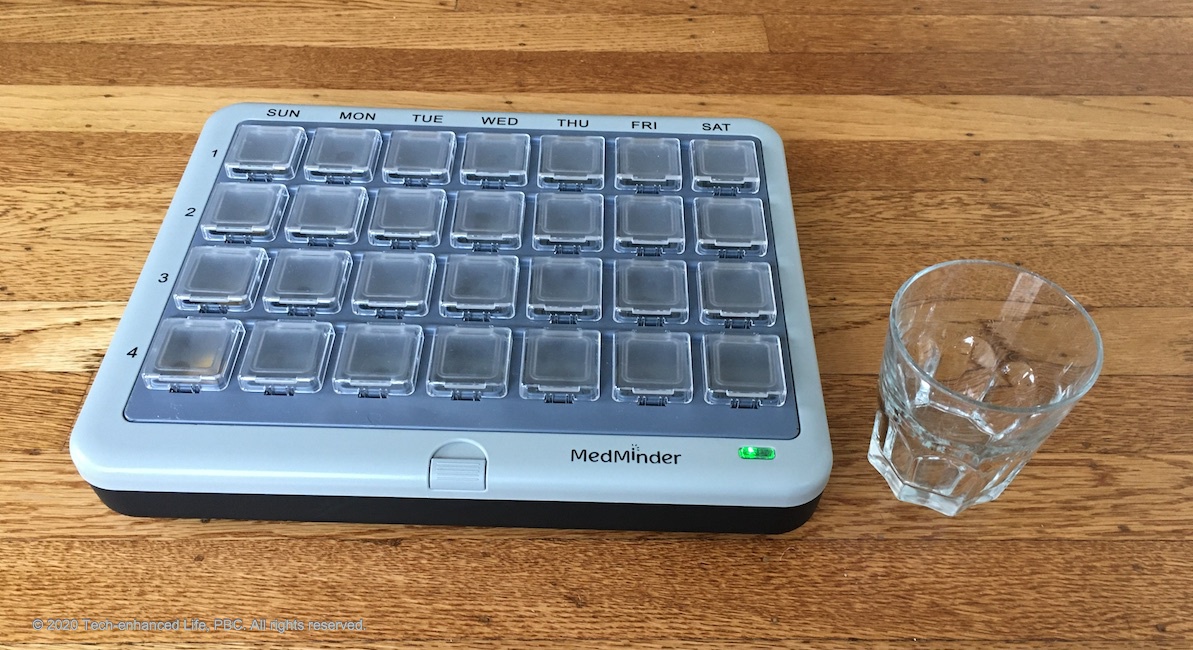
Caption: MedMinder has a very familiar “pill box” vibe.
Programming Medication Schedule
The MedMinder system itself has no real “programming interface” on it. Getting the right medications into the right compartment is either up to the “filler” or to the pharmacy (see filling below).
However, there is a web “portal” that connects to the MedMinder system, and in which you can adjust a variety of things relating to the machine.
For example, you can choose different approaches to notifying caregivers and reminding the dispensee. You can record specific voice prompts so that the dispensee is reminded in the voice of someone they know rather than just by beeps.
And you can enter in specific medications and specific medication routines. However, you would need to be careful that the routines you enter into the portal match the actual pills you put into the compartments. The machine does not do that for you. (In this it differs from products in the category of robot pill organizer / dispensers).
Limits on Complexity of Regimen
Think of the system like a smart pill box. It has 28 “slots”. The way it is configured means that you can set it up to do one dose per day for 28 days, 4 doses per day for 7 days, or variants in between.
It does NOT lend itself to being used easily for more than 4 “doses” per day. So for complex regimens that need more than 4 doses per day, this is not the right product. But bear in mind that a “dose” can include all the pills you can cram into one of the pill compartments. So it can handle lots of pills, so long as they can be grouped into no more than 4 groups per day.
If you need to take medication xx every 4 hours (6 times per day) then this product is not the right choice.
Filling (Putting Pills into the Device)
In our opinion, how well the product handles the “filling” step is a key differentiator between various pill dispenser systems and smart pill boxes. The MedMinder does an excellent job of offering options for this part of its functionality.
How Filling Happens
Option 1: You can simply fill the pill compartments by hand. You can lift the lid of the system and one by one add pills to each of the plastic containers in each of the 28 compartments. If you use the product in this fashion, it is really very similar to using a conventional pill box, with some additional reminder and tracking capabilities.
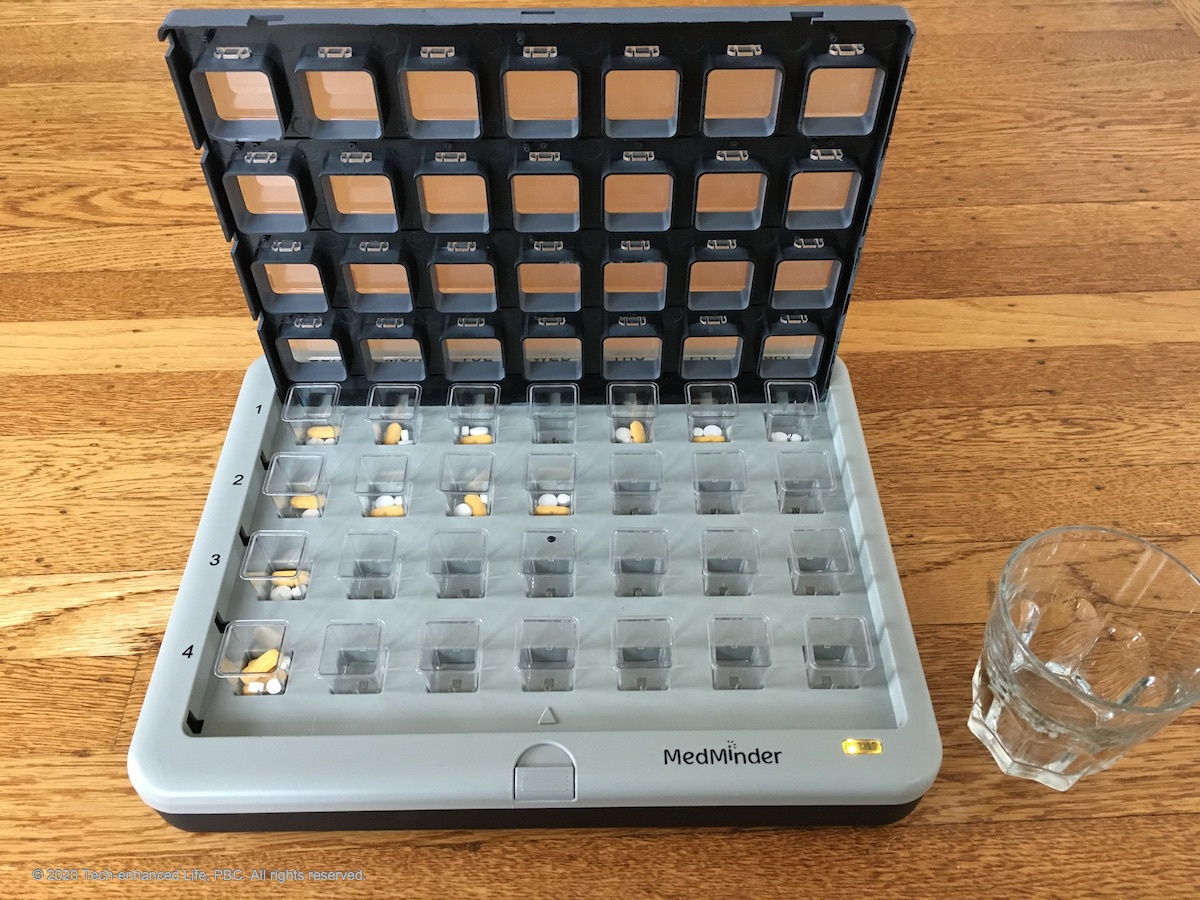
Caption: MedMinder ready to be filled.
Option 2: The product has been designed so that the individual plastic containers under the pill compartments are all connected by a cardboard template and the whole array of 28 containers can be lifted in and out of the system. And you can purchase extra ones.
This means a friend or caregiver can fill the entire tray of containers at a time and place of their choosing, then come by and drop the whole tray into the MedMinder system. This still requires a person to laboriously add pills one at a time to the tray of containers. But decoupling the filling from the machine itself is a definite convenience.
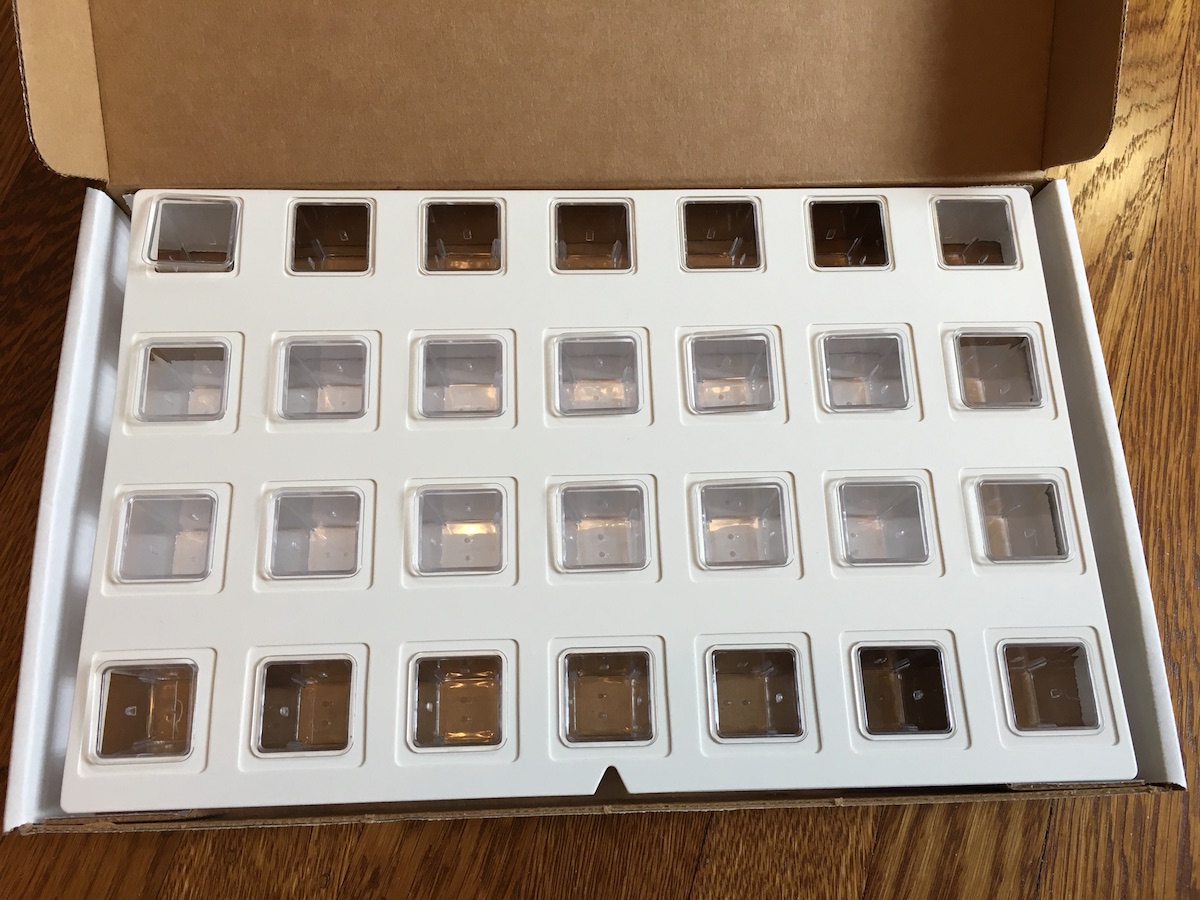
Caption: This entire tray can be filled remotely and dropped into the MedMinder.
Option 3: MedMinder also operates a pharmacy which can fill the trays shown above for you — and send them to you each week or each month by mail/delivery service.
This way, the pharmacy is responsible for correctly putting individual groups of pills together into each of the small plastic containers. And when it comes in the mail, either the dispensee or a caregiver simply has to place the entire tray of pre-filled containers into the MedMinder system.
This eliminates the need for you or a caregiver to place pills one by one into a pill box each week.
The MedMinder website claims there is no extra cost for the pharmacy to do this filling and delivering for you (beyond the normal copay). We did not try out this aspect of the service. But it is a similar idea to the way PillPack (and some competitors) package up your pills for you and send them out each week or each month. Our guess is that this approach probably works really well. If you try it, please add comments below and let us know.
Capacity
The system has some limitations to its flexibility (28 slots), but can handle quite a large number of pills. See Automatic Pill Dispensers: Hands-on Evaluations for a chart with “capacity” comparisons between this and the competing products.
Camera / Barcode Scanner / Medication Database
There is no medication database or barcode recognition capability.
Dispensing: The Interface for the Dispensee (person taking the pills)
The MedMinder looks like a fairly conventional pill box, although it is much larger, and plugs into a power outlet. It has 28 pill compartments, and like a normal pill box you use it by opening the appropriate compartment lid, and lifting out the pills you need to take at that specific time.
For example, if you take 4 different groups of pills at four different times each day, each “compartment” would include the pill group for one of those “times”. Thus 28 compartments allows you to have four “groups of pills” per day for a week, or one group of pills each day for a 4 week period (28 days). After that, you or someone else refills the system.
Inside each pill compartment is a small plastic container (cup). When it is time to take the pills in that compartment you lift out the plastic cup, take out the pills (ie put them in your mouth), and then you replace the plastic container, close the lid of the pill compartment, and move on.
NOTE: The system “knows” whether or not you take the small pill cup out of the pill box after you open up the pill box compartment. So, you need to actually pick up the pills before it decides you have “taken them”.
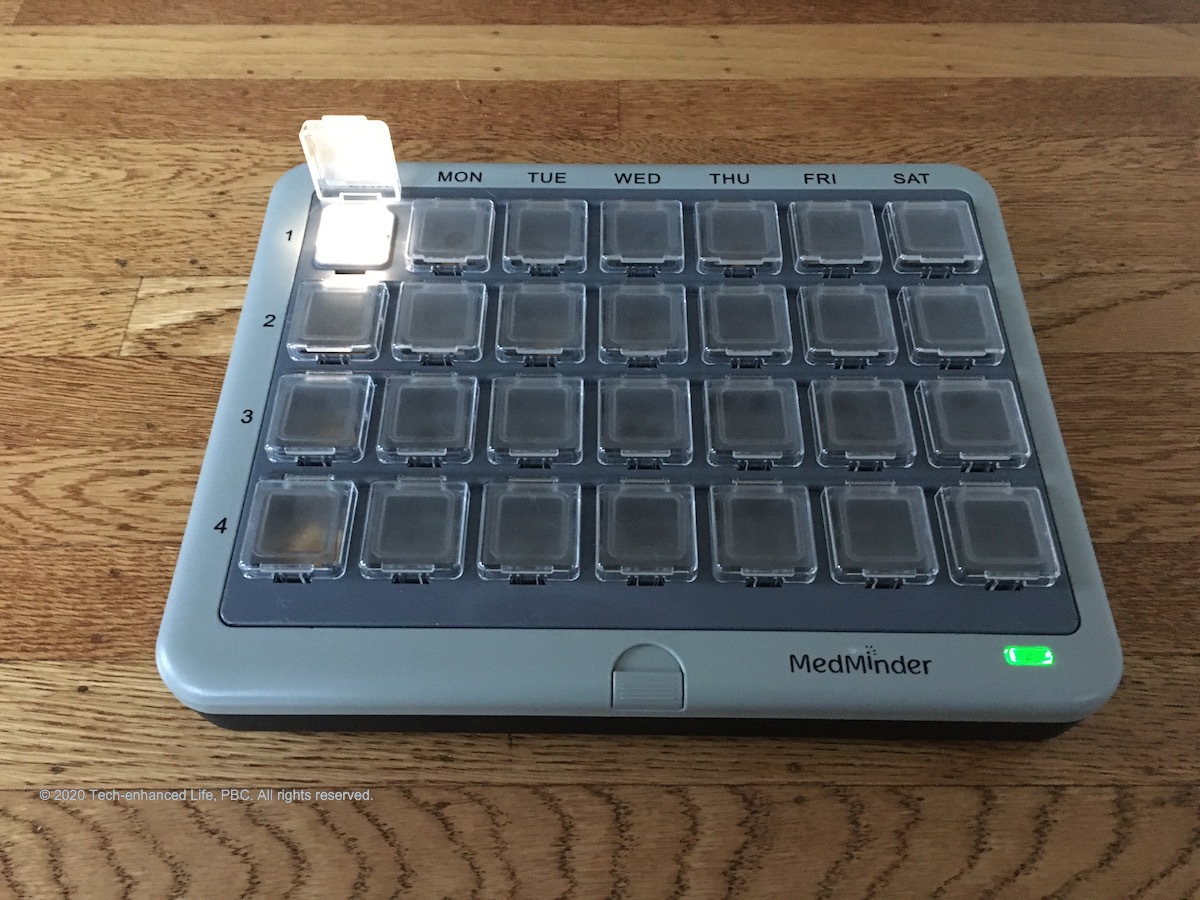
Caption: MedMinder is “Ready for you to take your pills”.
How it Communicates: Voice, Beeps, Lights etc
The system has a well thought out series of escalating “communication modes”. For our “dose”, which we set at 8am, for example, it does the following.
At 7.30am it starts a flashing light. If you have not yet taken the dose, at 8am it starts beeping. At 8.30, if you still have not taken the dose, someone calls you up by phone.
In place of a “beep” you can record a message in your own (or your spouse’s) voice and have it “remind you” in that familiar voice.
Early / Late / Missed Doses / Flexibility
With the Maya, you have quite a lot of flexibility. You can open the compartments in the “pill box” at any time, and take out doses early or late. Or you can take out a whole week’s doses if you are travelling.
With the Jon, which has a lock, this is more difficult, but also there is less possibility of taking out the wrong thing.
The Right Pills at the Right Time.
As part of the “setup”, the system is informed when you are meant to take the pills, and in how many groups, and the compartments are all filled with the appropriate pills. This is a critical step, and the idea behind this product is that normally that will be done by someone other than the dispensee.
At the appropriate time to take a group of pills, the MedMinder system starts beeping, and a light flashes on the pill compartment you are meant to open. It keeps flashing until you actually open the compartment, take out the plastic container with the pills in it, and then put it back.
If you do not extract the pills when it wants you to, there are an escalating system of notifications that can be set up to remind you and also to remind a “caregiver”.
Separation between Dispensee and Filler Roles
An important aspect of products like this is whether or not they lend themselves to being used in situations where the “filler” and “dispensee” are two distinct people. And, in particular whether or not they can be set up so that the Dispensee can be prevented from adjusting the medications and or taking the wrong pills at the wrong time.
For the MedMinder Maya, there is not a hard separation between these roles. The Dispensee can adjust the contents of the pill compartments, and can take out pills other than those that are “supposed to be taken out”. The company makes a second very similar product called MedMinder Jon (instead of MedMinder Maya). In that product (see security section below), a lock prevents the Dispensee from adjusting medication or taking the wrong pills at the wrong time.
Physical & Cognitive Impairments
In terms of physical impairments, the system seems well designed. The compartments are large and easy to open. The light that flashes to notify you is bright. And the sound is loud. There is no requirement for reading small print or pressing small buttons.
In terms of Dispensees with cognition impairments, we think it likely to be an advantage that it “looks and acts like a pill box”, which is familiar to many people already. And the product does not require processing words on a screen and buttons simultaneously (there is no screen).
The Jon model, which comes with locking compartments, would likely be what you would choose in situations where the Dispensee has cognition challenges.
“Time to Refill”
This system is designed to work on a schedule in which it gets filled weekly or every 2 or 4 weeks, depending on the number of medications. It can be set up to remind a caregiver, and to notify a caregiver if the “refill” has not taken place.
Set Up & Connectivity
Connectivity
The MedMinder system connects to the internet using its own built in cellular connection. So, there is no need to fiddle with connecting it to WiFi, and you do not need an Internet connection in your house at all. However, there needs to be a good cellular signal in the room you put the product in.
According to customer support, the carriers they use are “AT&T and T Mobile”, and so you need a robust cell signal strength from one of those carriers in the room of the house in which the product will be placed.
General Setup
Setting the system up for the first time requires turning it on, creating an account on the MedMinder portal and registering “your” product. Then you choose some settings relating to medication routine and notifications, and it is ready to go. As “setup” routines go, it seemed straightforward.
Portal or App
The portal is clearly capable of handling multiple MedMinder products in the same account — presumably targeting professional caregivers.
The portal allows you to look at a variety of reports, that track things like how often medication is taken on time, any missed refills, and an “Adherence Score”.
Remote medication adjustment
You enter your medications and schedule into the portal. And in particular, you tell the machine via the portal whether you want it to operate in a weekly configuration or a monthly one. And what time of the day you want the four possible “doses” to happen, and which pills you plan to load into each “dose container”. This controls which compartments light up and beep, and at what times.
The exact medication regimen is entirely dependent on the pills that are loaded into the different compartments of the system. If you do the filling yourself, then that is what affects the medication schedule. If you order the pills from the MedMinder pharmacy, then whatever the pharmacy has on record is what should be delivered. We are not certain if the “portal” entries you make get passed on to the pharmacy or not. We did not explore the interface with the pharmacy.
In any case, adjusting medication regimen requires you to physically change the pills in the containers in the system. You cannot make “on the fly” adjustments to the medication regimen by an App or the portal.
And if you order pills from the MedMinder pharmacy in pre-filled trays, there is a delay between when you ask for changes, and when the next tray arrives. If you get refills weekly, then each week could have an adjusted regimen. If you get refills only monthly, then you would expect the “new” regimen to start as of the next month’s tray.
If you need more frequent regimen adjustments, you would need to go in and make adjustments by hand to exactly which pills are where in the MedMinder pill compartments. This would be quite feasible, and no different than how you would handle medication changes if you used a regular pill box.
This is however one of the differences between this product and the class of “robot pill organizer / dispensers” — as with those products, you can adjust medication using the App or user interface on the system.
Caregiver Monitoring
The product clearly has in mind the scenario of a caregiver or family member who is involved in helping to manage the medications of someone else (an older adult for example). It can send notifications if the dispensee has not taken medication at the right time, or if they took medication from the wrong compartment at the wrong time.
Additional Features & Details
Security & Anti-tampering
The MedMinder “Maya” product allows you to take pills from any compartment at any time. If you take them from the wrong place or at the wrong time, it records that fact and notifies “caregivers” if set up to do so. But it does not “stop” you.
Dispensee with Cognitive Impairment
There is a different model of the product, called “Jon” rather than “Maya”, which actually locks the compartments, and which does not let the dispensee open any compartment except the one appropriate for that particular dose. This seems to us as if it should address the situation of a dispensee with cognitive impairment who might get confused as to which compartment to open and when.
“Others” Using your Meds
There is a separate situation which some of the products in this category worry about. That is the situation in which the wrong person takes “your” pills. A topical example is in the case of opioids, for example, where you do not want others with access to the house to be able to take “your” opioids. As bext we can see, this product does not really address this situation completely, although the lock in the Jon product would certainly help.
Hacking the System
Because it is connected to the Internet, it is theoretically possible someone could hack into and gain control of the system. In our opinion, anything connected to the Internet is potentially hackable, and we would bet this product is no exception. It’s like the decision to use a phone or a computer, or Alexa, or any other piece of useful technology. You make a decision whether the risk of being hacked does or does not outweigh the potential benefits. In this case the potential benefits are significant.
Power & Battery Backup
The system is designed to be plugged in to the power outlet. It includes a battery backup, which the company says lasts for 48 hours.
Vacations & Trips & Leaving the House
We went away for a couple of weeks while using the product. We simply turned it off and left it. When we returned we turned it back on, and it started working again immediately without needing any “set up”.
One possible advantage of this product compared to many of its competitors, is that, while relatively large, it is a sort of rectangular shape and size that you could imagine packing in your suitcase if you decided you really wanted to take it with you.
We note that the MedMinder pharmacy offers different packaging options as well as the standard trays that go in the MedMinder system. So you could probably ask to get special “travel packs” of pills for a vacation.
And for day-to-day use, when you realize that you need to leave earlier than the scheduled dose, or be away for it, there is nothing to stop you opening up specific compartments, and taking the containers with you, or decanting the pills from them into a small “day pill box” you could take with you.
Aesthetics
While some people may not care what the product looks like, others do. Overall it is not a glamorous or elegant product. It looks like a large and functional piece of electronics, but not something many people would wish to “show off”. But the fact that it looks and feels like a “pill box” will be an advantage in terms of familiarity.
Manual, Support, Training
It comes with a 4 page glossy pamphlet that contains most of what you need to know. It is sufficiently simple that you don’t really need a “manual”. Which is lucky, because it does not come with one.
Languages: Documentation and the interface seem to only come in “English”.
Where to buy it or learn more*: (this takes you away from our website)

Discount for Tech-enhanced Life readers:
- Discount code:
- Discount amount:
*Disclosure: The research and opinions in this article are those of the author, and may or may not reflect the official views of Tech-enhanced Life.
If you use the links on this website when you buy products we write about, we may earn commissions from qualifying purchases as an Amazon Associate or other affiliate program participant. This does not affect the price you pay. We use the (modest) income to help fund our research.
In some cases, when we evaluate products and services, we ask the vendor to loan us the products we review (so we don’t need to buy them). Beyond the above, Tech-enhanced Life has no financial interest in any products or services discussed here, and this article is not sponsored by the vendor or any third party. See How we Fund our Work.
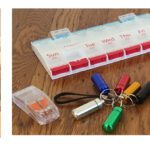
Is there a way to turn down
Is there a way to turn down the volume
What do they charge?
What do they charge?
My 88 year old mom has NO
My 88 year old mom has NO technology available! The best she can master is the TV remote. Which pill dispenser can operate with only electricity or battery?